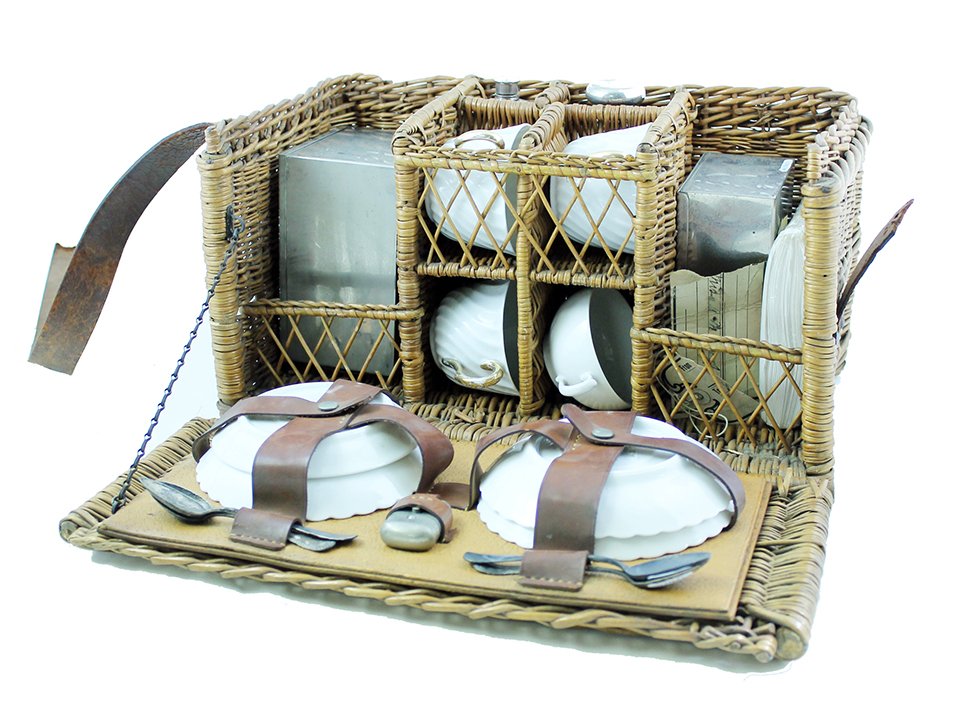 This portable tea set belonged to Alice Longfellow, and probably dates from the late-19th or early-20th century. It consists of porcelain cups and saucers, silver spoons, a glass bottle that likely held alcohol fuel for a burner, two metal containers for food and tea storage, a small metal matchbox, and a package of inexpensive paper napkins wrapped in cellophane that appears to have been a later addition. One of the cup and saucer pairings and two of the silver spoons do not match the rest of the pieces, indicating that perhaps the set received considerable use and items may have been lost or broken along the way, necessitating replacement. A key pair of articles are missing, namely the teapot and the burner. The underside of the lid (not pictured here) is lined with metal, to serve as a platform for heating the tea with the (now missing) burner. All the paraphernalia is housed in a cleverly designed wicker basket, with separate compartments and leather straps to keep everything securely contained and neatly organized. A tag inscribed with Alice Longfellow’s name gives us a clue as to who owned this kit.
This portable tea set belonged to Alice Longfellow, and probably dates from the late-19th or early-20th century. It consists of porcelain cups and saucers, silver spoons, a glass bottle that likely held alcohol fuel for a burner, two metal containers for food and tea storage, a small metal matchbox, and a package of inexpensive paper napkins wrapped in cellophane that appears to have been a later addition. One of the cup and saucer pairings and two of the silver spoons do not match the rest of the pieces, indicating that perhaps the set received considerable use and items may have been lost or broken along the way, necessitating replacement. A key pair of articles are missing, namely the teapot and the burner. The underside of the lid (not pictured here) is lined with metal, to serve as a platform for heating the tea with the (now missing) burner. All the paraphernalia is housed in a cleverly designed wicker basket, with separate compartments and leather straps to keep everything securely contained and neatly organized. A tag inscribed with Alice Longfellow’s name gives us a clue as to who owned this kit.Sets like this were in use by the 1850s in England, supplied by manufacturers such as G.W. Scott and Sons and Drew and Sons of London. They were primarily intended for use by the public, but in the early stages of World War I many were brought to the front lines by officers in the British Army, before the grim nature of the war became truly apparent and such comforts were largely dispensed with. Picnicking as a leisure activity in the United States really took off in popularity during the later 1800s and early 1900s, and “picnic groves” were established in many urban areas to satisfy the desires of those who wanted to dine in the outdoors without traveling far from home. As hinted at by the nature of this tea set, the victuals offered at these outings could be rather elaborate, with entire cakes, an assortment of cold meats such as lamb or roast duck, and a wide array of desserts being commonly provided.
Photographs of extended members of the Longfellow family show them picnicking, often in Maine. Alice Longfellow may have taken this set with her on picnics, camping trips, or even on some of her trips to Europe, as she generally travelled in style, whether she was visiting Italy or camping in the northern Maine woods. A tea set like this one would not have been seen as an unusual item amongst the rest of her luggage.
